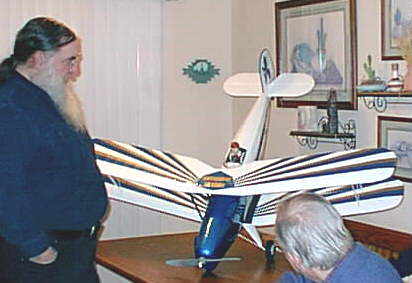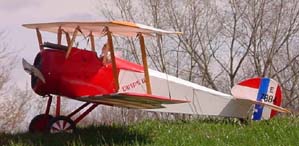 |
Flying High With Electric Power!
The Ampeer ON-LINE!
Fly the Future - Fly Electric! |
Site Table of Contents
| President: | Vice-President: | Secretary/Treasurer: |
| Ken Myers | Richard Utkan | Rick Sawicki |
| 5256 Wildcat | 240 Cabinet | 5089 Ledgewood Ct. W. |
| Croswell, MI 48422 | Milford, MI 48381 | Commerce Twp., MI 48382 |
| (810) 679-3238 | (248) 685-1705 | 248.685.7056 |
 | ||
| Board of Directors: | Board of Directors: | Ampeer Editor |
| David Stacer | Jack Lemon | Ken Myers |
| 16575 Brookland Blvd. | 8908 Sandy Ridge Dr. | 5256 Wildcat Rd. |
| Northville, MI 48167 | White Lake, MI 48386 | Croswell, MI 48422 |
| 248.924.2324 | 248.698.4683 | 810.679.3238 |
| Mailed Ampeer subscriptions are $10 a year US & Canada and $17 a year world wide. FREE on-line! | ||
| The Next Meeting: Date: Saturday, Aug. 6 Time: 10:00 a.m. Place Midwest RC Society 5 Mi Rd. Field - Mid-Am | ||
|
ARVADA ASSOCIATED AIRPARK FIRST ANNUAL ROCKY MOUNTAIN ELECTRIC FUN FLY Saturday, July 30th, 9 am to 4 pm Hosted by the Rocky Mountain Electric Flyers in cooperation with the Arvada Associated Modellers
EVENTS Speed 400 7 cell LMR Sailplane, AMA Event 610 except 45 second motor run, 5 minute glide, no spot landing. 7 cell NiMH or NiCad only, brushed 400 only, gear drive and folders OK. 3 Rounds. Limbo- Any plane, motor, battery. Starting height 10 feet. 25 points each lower pass, double points for inverted limbo pass. 2 attempts per contestant at each pole height. Helicopter Pad Hop (4 pads, 10 foot square layout). 2 attempts per contestant, lowest single elapsed time wins. GWS SLO STIK Precision Flight. Any Motor and Battery. Aircraft must be GWS "Slo Stik". R.O.G., 3 Loops, 3 Touch-and-Go's, Spot Landing, 2 minute flight. Each second over/under, 1 point lost. Maximum Flight score 120 Points. Landing (10 Foot circle) 10 Points; Inner (5 Foot Circle) 20 Points. Entire Aircraft must be stopped in circle. 2 Attempts per contestant. FUN FLYS ALL DAY! ALL ELECTRICS WELCOME! SUPPORT E-POWER IN COLORADO Best Finish/Covering (static), Pilots Choice (overall), Best Original Design. ENTRY AMA License required to fly, $ 10.00 Entry fee (includes one event) $ 5.00 each additional event. No age categories (open only). Spectators FREE. Raffles too! No pre-entry, registration starts 8:00 a.m. Cash only. Contest Director George Baxter Flying Demonstrations- E-Helicoptors, Hotliners, 3D, Ducted Fans, E- Vintage and E-Oldtimer. Contact Information: www.rmeflyers.org/funfly2005.htm or; rmefrbe@aol.com (720) 220 3384 BATTLE CREEK BALSA BEES
Saturday, AUGUST 27th, 2005
Pilot's Fee $5.00 INCLUDES Hot Dog Lunch
Pilots briefing 9:00am
Spectators are welcome and entry to the field is free. The BALSA BEES flying site is located SOUTH OF I-94 EXIT 100 (Beadle Lake Road) approx. 5 1/2 miles to D Drive South, then WEST approx. 3/4 mile. Follow Beadle Lake Road past Beadle Lake, Harper Creek High School, Binder Park Zoo. Cell phone help will be 269-275-9272. Modern Porta-Potti will be available but no running water. Cold soft drinks and water will be available. Contact Event Chair at 269-979-9272, or email at NSCALENUTS@AOL.COM Licking County Radio Control Club Electric Fly-In
(Night Flying Permitted with proper equipment) Tailgate Swap All Transmitters MUST be impounded or inspected for battery removal All AMA RC Pilots are Invited Free Food and Drinks for ALL Pilots
NO Registration Fee
Come One, Come All
Contact Don Wise, 740-345-9167, donwise@alltel.net
Jungmann Is Back, Again!
I flew the Jungmann last night with a 7-cell 3.2Ahr Kokam 20C/40C pack. It's back!!!! I was disappointed with the original e-conversion, I think I wrote you about it before with all the details. (see info below from April 2003 Ampeer KM)
From the April 2003 Ampeer My restored Jungmann has an Aveox 1412/4Y on 20 CP1700s or 2000NiMH, with a Modelair-Tech H-500 belt drive, 2.6:1 ratio. Initial prop tests show 15x10 @ 5.5K @ 23 amps, so I may go up to a 16x10 or 16x12 after flight tests. A 15.5" prop is scale diameter.
If not noted by Keith the Data has been approximated by Ken Myers Wing Area: 840 sq.in.
E-flight in Nebraska
Ken, Electric is alive and well in Omaha, Nebraska.
Larry Bailey Here is some info from Dan Cramer (via Larry Bailey), dan.cramer@cox.net, Bellevue, Nebraska about his Electric Sig Senior. |
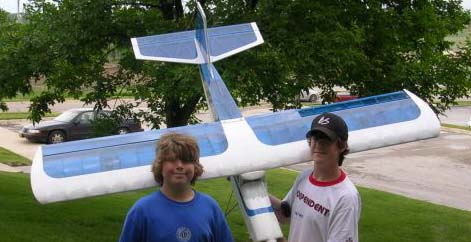
|
The first photo is the Senior being held by my son James (14) and Jacob (12) on his left. This is the first plane James has ever flown and he completely soloed on his fourth flight. He thought he was ready earlier, but Dad was nervous, not him.
|
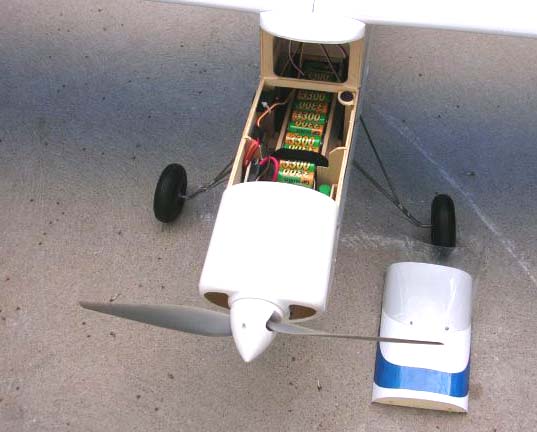
|
The second photo is of the hatch removed (Bob cut this part of the fuselage which is solid structure in the original ARF). You can see the battery mounting tray and associated Velcro strap, ESC, RX battery, etc. There are cooling holes in the cowl.
Dan |
Motor Definitions Comments
Ken, Misplaced the April Ampeer, but just found it and was looking at it until I saw your method of comparing motors on page 4. This is what I use when possible (not always possible when all info not available). I seldom build kits, but if I have the weight, size of prop, RPM and current at a certain voltage, I can make a comparison to other motors and decide what to do design for the best one.
Okay Weldon, here goes. First of all, I don't believe that the manufacturers will ever give us the numbers we need to compare motors. That would be way too easy! What we need are, and this is very important, real Kv, Rm and Io for the motor in question. We also need real prop and cell tests with specific brand name props and specific brand name cells. I believe that Model Motors has tried to do this, from looking at the data on their site, but there seems to be a very large variation in their actual production motors.
I have the Model Motors AXI 2820/10 and Castle Creations Phoenix 45. My problem is that it is drawing too much current and spinning too fast compared to all the data I have been able to find on the AXI 2820/10. The problem is that I can't use the prop I want when using 10 cells. The largest prop I can use on 10 cells is the APC 10x7e. The CC Phoenix 45 has the following settings:
10-cell pack is composed of Sanyo RC1700 cells (yes, it's a few days old ;-) ) Test Equipment:
Volts, amps and RPM are collected at the same time and written down using the playback of the Camcorder. Here is my bench test data from several days of tests. These numbers are averages from doing the following 4 times, for a series of three tests. All runs were for 5 seconds at maximum throttle using the counting method, one thousand one, one thousand two, etc. At no time did the motor or controller ever become warm. The pack was recharged after four runs and there was quite a bit of cooling off time between each series of runs. Air temperature was between 60 and 65 degrees F with fair weather on all days of testing. According to a Google search the elevation here is somewhere between 750 feet and 800 feet above sea level. Each run consisted of a motor run with no prop for Io, then motor run with small stick to get RPM, Amp & volt readings for figuring mathematical Kv and Rm and the final run was done to collect RPM, Amp & volt readings using the High Point balanced APC 10x7e prop. These were followed by three more runs in the same order. A total of 4 of these run-throughs were on the pack before recharging and collecting the data via Camcorder playback. The data is presented with two decimal places, even though the Whattmeter only reads to one, because it is the average for the 4 runs. Standard Advance:
Low Advance:
As would be expected, the Low Advance has slightly higher volts and RPM and slightly lower amps. When I first started the testing, I wanted to use the APC 11x7e as the upper end of the tests, as I did not have an APC 12x6e, which is where I really wanted to start. The first time I tired to run the 11x7e, the ESC cutoff quickly. That is when I changed the cutoff on the Phoenix 45 to insensitive. I ran up the 11x7e and when I saw on the monitor that I use 53 amps while taping the data, I immediately shut down. From that point on, the 10x7e was the prop I used. I wanted to use this motor with the 11x7e and a 3S1P Kokam 2.1Ah 20C Li-Poly pack. I don't have the taps on that pack yet for charging the individual cells to equalize them, that is why I used the RC1700's. I based my motor selection on the following data:
The problem is that the 10x7e is pulling like a 12x8e, but showing much higher RPM, almost 3000 when compared to the 12x8e, based on the flyingmodels.org site data. This also is reflected in the Kv and Rm when derived mathematically.
At first I thought that my good old NorCal tach was not working correctly, that is why I purchased the Hobbico tach, and as noted, the two units track very closely in the RPM range I was recording. I did just two recordings of the 7-cell Panasonic 2Ah pack on the APC 10x7e prop with an average of 7.28v, 25.15 amps, 7975 RPM. I had pulled 150mAh out of the pack using my discharger, so that it wasnÕt peaked, before taking these readings.
I guess there are several problems here:
One other curiosity is that after connecting the battery to the ESC, when I start to open the throttle, the motor runs in reverse for about a second and then reverses itself to forward rotation. Thoughts and comments appreciated. Ken Myers, Croswell, MI USA It should be noted that I verified my tach and new tack with other tachs and my Whattmeter with another Whattmeter. Here is some more information that I posted to the thread: I put this motor in my TigerShark sport plane last night. 488 sq.in. and with the motor/controller/mount change 53.6 oz. It was 57.4 oz. before the switch over to the AXI 2820/10 and Phoenix controller. The power system replaced the original AF035G 2.82:1, Jomar SM-4 ESC and 250mAH Rx pack and the same prop. That power system turned the same MA 10x6 standard wood prop at about 8,600 RPM. I plan to fly it today at the EFO flying meeting. I'm going to use the same Master Airscrew standard wood 10x6 prop. Average static volts, 10 - amps, 38.5 - RPM, 10590 on 10 RC1700. Computed Kv 1315, Rm 0.050, Io 3 amps I flew the system in the TS on Saturday. The second flight was interesting, as I tached the prop before flying. I had several folks help me, and I told them I expected at least 10,600 RPM. Well, the second flight on a Ni-Cad pack syndrome kicked in. It was closer to 11,500 RPM! This is the oddest motor I've ever run across. I didn't take a watt or volt readings, but obviously the volts were up even higher, and therefore the amps must have been too, but the CC Phoenix 45 never kicked out. I was able to do a vertical roll, which the plane had never done before.
I guess the bottom line is that even when we do have all the numbers, there seems to be a much larger variation in individual motors than I previously had expected. As always your thoughts and comments will be appreciated. KM Thoughts on Going Li-Po
I finally went Li-Po. After research, I found that the Poly Quest has more to offer, i.e. separate taps to check and also charge individual cells with their PCM charge guard. They are about the same prices as others. They have a narrow size to fit in skinny fuselages. They sell directly to you at eflightpacks.com.
Voltage difference between 10 cell NiCad, 10 cell Ni-MH and 3 cell Li-Po
I agree with you about some of the reviews in the model magazines. Some guys are getting on the electric bandwagon and don't know what they are talking about.
Upcoming PMAC Electric Meet On August 7 the Pontiac Miniature Aircraft Club (PMAC) presents its electric fly-in, "Electrics Over White Lake". It will be held at the PMAC field in the Pontiac Lake Recreation Area. The field is located off of White Lake Rd. just east of Teggerdine Rd. Contact Sterling Smith, 248.673.2882 or email smitty559@comcast.net Flying starts at 10:00 a.m. Click here for flyer One More Day of Flying
Looks like yesterday was the last for flying this winter trip down here. (Rich lives in South Dennis, MA in the summer. KM) Tom Kempf thought we should have one more day, so I took him up on it, hence the enclosed photos.
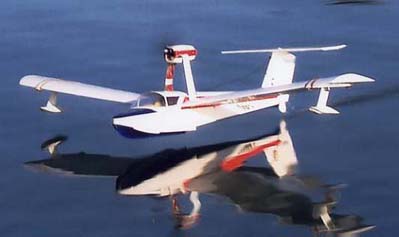 Here's our Donald 4 from Hobby Lobby. With a new Mega AC 22/10/06 combined with a Castle Creations Phoenix 35 brushless ESC it gets off the water fast - lots of power. In the photo it has just taken off. Performance is outstanding. 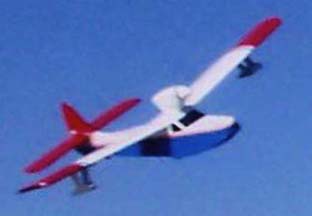 The other photo is of our 80% scratch-built Dreamboat flying boat shown coming about. It is powered by a Mega AC 16/15/5 combined with a Castle Creations Phoenix 25 brushless sensorless speed control. It ROW's quickly and flies well. Camel Finally Flies!
Nearly two years ago I sent you a photo of my VK Camel in the bones. Here are some finished photos. These are before the rebuild following a severe crash on the initial test flight. My "helper" responded to my request for "two clicks of up elevator" by giving me FULL up trim resulting in an instant unplanned loop and snap spin with predictable results. It took me six months to cool off enough to look at the wreckage and realize that it wouldn't be all that hard to rebuild it. I finished the rebuild a month ago and have been waiting for the wind to ease off.
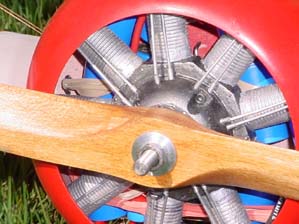 The rotary motor was made from balsa, aluminum tubing and common pins. The fins were accomplished by running a threaded pipe coupler over a piece of rounded balsa stock. Details: WS 59in, WA approx 700 sq.in., Wt 7 1/2 lbs. Motor Astro 25 w/Superbox on twenty PA3000 Ni-MH; Astro ESC, UBEC; Servos: mixture of Hitec, Futaba and Airtronics. (dual aileron servos with 50% differential). Test flight prop MA 16/10 (non-E). Flight time is approximately 8 minutes with full power for landing. It isn't as pretty now, but I hope to bring to the Mid-America if all goes well. Walt Thyng 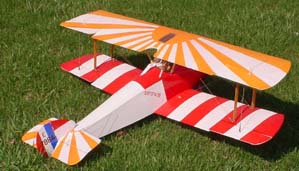 Coldwater Meet Report
Dave Grife had another very successful "Keith Shaw Birthday E-Fly In". The new runway was in absolutely perfect condition. This meet is great because it is a really laid back time of flying. With about 30 of our closest flying friends, this is the meet I enjoy most every year.  Jim Ryan's fleet of great Sp400 planes can be seen in the photo above, as well as Jim Young's Hughes H-1. 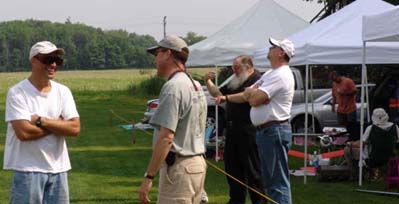 A shot down the flight line shows a lot of activity on the field, as well as in the pits. 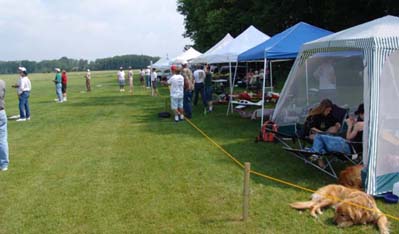 Dave can be seen with a big, well deserved smile on his face with the birthday boy in the background.
|
To Reach Ken Myers, you can land mail to the address at the top of the page. My E-mail
address is:
KMyersEFO@aol.com
EFO WEBsite: http://members.aol.com/KMyersEFO/
